Three different Bermuda locations were combined to create Romer Treece's (Robert Shaw) Saint David's Lighthouse. These were:
To avoid confusion there is a real Saint David's Lighthouse at Saint David's Island in Bermuda, which is where Peter Benchley's novel The Deep is set. However, the majority of the movie's exterior Saint David's scenes were filmed instead at Coney Island, Bermuda. We'll look at all three locations in detail below.
Coney Island
An exterior facade, which explodes at the end of the film, once existed at Coney Island, Bermuda. The location does not have a specific postal address but the set lay on top of Coney Island hill approximately 100 metres from the Department of Environmental Protection, Marine Resources cottage at 3 Coney Island Road, Saint George, Bermuda, CR 04. The Marine Resources cottage was the filming location of 'Kevin's lunch' where Kevin and Ronald had their outboard motor fight.
 |
Treece's Lighthouse set on Coney Island hill seen from the Bermuda Causeway (Source Sony Pictures)
|
The set was built at Coney Island instead of Saint David's for three reasons. First, the plot required the lighthouse to be blown up which couldn't happen to the real Saint David's Lighthouse which is still a fully functioning lighthouse. Secondly, in Peter Benchley's novel "The lighthouse sat on a flat promontory, so high above the sea that the light itself needed to be only fifty or sixty feet above the ground"; whereas the real Saint David's Lighthouse is back from the ocean and surrounded by other buildings as can be seen in Google StreetView below.
Thirdly, the real Saint David's Lighthouse was too tall for Panavision's anamorphic format.
The character of Romer Treece was based upon the life of Bermuda explorer Teddy Tucker who worked as a consultant on the film supplying a variety of services during production. The lighthouse exterior was dressed with real artefacts including grindstones that Tucker raised from the wreck of the Caeser.
Tucker was filmed salvaging grindstones and other items from the Caeser in 1961.
Nick Nolte and Jacqueline Bisset reached "Saint David's Island" (which was really Coney Island) by crossing the historic Coney Island Bridge. A bridge has existed here for approximately 400 years and was one of the first three bridges to be built in Bermuda.
 |
| Jacqueline Bisset and Nick Nolte cross historic Coney Island Bridge (Source Sony Pictures) |
|
A series of large concrete pylons run alongside the bridge and continue across the harbour to the right of Robert Shaw below.
The pylons are the remains of the Bermuda Railway which is now the Bermuda Railway Trail. In some scenes there was a fleeting glimpse of a small hut next to the railway pylon at the tip (North Point) of Coney Island.
The tiny shelter is still there and you can step right up to it:
When Jacqueline Bisset and Nick Nolte first climbed the lighthouse steps (below) the audience was treated to a rich view of Castle Harbour behind them, including Bermuda Airport (Kindley Field) in the distance on the opposite side of the harbour, and the Bermuda Causeway (far right), as it appeared in 1976.
 |
| Jacqueline Bisset and Nick Nolte climb the steps of Treece's Lighthouse (Source Sony Pictures). |
The same view can still be enjoyed.
By 1973, when the following aerial picture was taken, Coney Island resembled what producer Peter Guber described as "a barren little handful of sand and rock".
Reforestation has since covered most of the dirt motocross tracks that were visible when The Deep was filmed.
Toward the end of the film Robert Shaw walked down a dirt track from the lighthouse toward the shoreline. He paused, then stepped onto the small beach heading to nearby "Kevin's lunch" (Marine Resources Cottage).
 |
| "Adam, I think I'll take a breath of air" Robert Shaw as Romer Treece walks down Coney Island Hill in 1976 (Source Sony Pictures). |
The 1973 aerial photo makes it possible to recognise exactly where Robert Shaw was walking.
Royal Naval Dockyard Sail Loft
The set was designed by Tony Masters (of 2001: A Space Odyssey renown), construction supervised by Dick Frift, and decorated by Vernon Dixon. When the Art Directors Guild inducted Tony Masters into their Hall of Fame his work was described as "... obsessed with detail and accuracy. Every single element of the production design, right down to the seemingly most insignificant, were to be designed with technological and scientific accuracy in mind." While the perfection seen in 2001: A Space Odyssey was a vision of the future The Deep lighthouse interior was a perfectly layered view of the past.
The DIY workshop style of Treece's home is rooted in the home laboratory tradition of Bermuda's early maritime explorers. Bermudian explorer Teddy Tucker, who inspired the character of Romer Treece (Robert Shaw), began much of his artefact restoration in the family dining room.
 |
Wendy, Edna and Teddy Tucker in their home dining room which doubled as a workshop (Source Life)
|
The set recreated the dining room style workplace and infused the story's shipwreck plot with books and art linked to Spain's maritime history.
Versions of real artefacts Tucker discovered on Bermuda wrecks are behind Nick Nolte including a short sword recovered by Tucker in 1959.
These particular artefacts (above) resemble those found in 1959 by Tucker and his brothers-in-law, Donald and Robert Canton, on a wreck believed to be a Spanish freight ship, the Vigo (1637).
The painting to the right of Jacqueline Bisset, at the top of the stairs, is a copy of English Ships and the Spanish Armada, August 1588. The original painting is kept at the National Maritime Museum, in Greenwich, UK.
 |
| English Ships and the Spanish Armada, August 1588, artist unknown, English School 16th century (Source National Maritime Museum, Greenwich) |
A copy of the same painting hangs in the David P. Gutteridge Gallery at Dockyard's Queen's Exhibition Hall which was the location of the 'Hamilton Library' scene.
Seville monopolised Spanish trade with the New World for hundreds of years and much of the gold that crossed the Atlantic was smelted at the Royal Mint of Seville (Casa de la Moneda). On the wall above Bisset, where she sits on the stairs, is the engraving View of Seville from the Southwest Side (also called Seville in the 16th century).
Tony Masters also incorporated the work of German Renaissance artist, Albrecht Dürer (1471-1528) into the set. Dürer's connection to Bermuda's maritime history began when Smithsonian curator of Naval History, Mendel Peterson, who Bermudian explorer Teddy Tucker once described as the founder of marine archaeology (LookBermuda, 2014), referenced Dürer in his 1975 book The Funnel of Gold.
According to Peter Benchley, in the 1960s Teddy Tucker's family home became a base camp for maritime experts from the Smithsonian Institution, including Mendel Peterson. When Peterson documented some of Tucker's findings, in Funnel of Gold, he also referenced Dürer's 1520 visit to the Brussels Town Hall to view the objects sent to the King of Spain by Hernan Cortes:
"I saw the things which have been brought to the King from the new land of gold, a sun all of gold a whole fathom broad, and a moon all of silver of the same size, also two rooms full of armour of the people there, and all manner of wondrous weapons of theirs, harness and darts, very strange clothing, beds, and all kinds of wonderful objects of human use, much better worth seeing than prodigies. These things were all so precious that they are valued at 100,000 florins. All the days of my life I have seen nothing that rejoiced my heart so much as these things, for I saw amongst them wonderful works of art, and I marvelled at the subtle Ingenia of men in foreign lands. Indeed I cannot express all that I thought there." (Conway, 1958)
Peterson described how in 1519, the Aztec king Montezuma (or Montezuma II), attempted to prevent the conquest of his Aztec capital Tenochtitlan by bribing Cortes to leave the country. The bribe consisted of the rich gifts that Cortes quickly sent back to Spain before he left Veracruz to conquer Tenochtitlan. Montezuma's treasure sailed past Bermuda and on to Seville where it was quickly delivered to the Holy Roman Emperor Charles V (1500-1558). Peterson illustrated Cortes' troops using Dürer’s Knight on Horseback, Facing Right, with a Dog.
Funnel of Gold included Peterson's first hand account of working in Bermuda with Teddy Tucker, the Canton brothers (Tucker's brothers-in-law) and photographer Peter Stackpole, all of whom are linked to the birth of maritime archaeology in Bermuda:
"... the Tucker-Canton find remains the richest historically of any discovery in the Western Hemisphere. The emerald cross is without equal for beauty and historical and intrinsic value, being the most valuable single object known to have come from the sea in modern times."(Peterson, 1975)
 |
A 'plot stack' hidden beneath Treece's table (Source Sony Pictures)
|
On the bottom of the stack is Great Prints and Printmakers by Herman J Wechsler. This book contains Dürer's The Sea Monster (Das Meerwunder) and Adam and Eve both of which could be seen as analogous to David and Gail, and Bermuda.
Treece's collection also includes a copy of The Star Atlas by maritime writer S.S Rabl (Samuel Suplee Rabl) and a Spanish language edition of Björn Landström's beautifully illustrated The Ship (El Buque). El Buque contains a woodcut of a 15th century carrack (below right) almost identical to the distant vessel in Dürer's Sea Monster (below left) and The Deep's Grifon.
 |
| Detail of carrack from Dürer's The Sea Monster (left) and the Breydenbach Pilgrimage carrack of 1486 (right, coloured red) from Landström's El Buque (Landström, 1961). |
As Gail studies a book of paintings she is distracted when Romer Treece (Robert Shaw) reads out a list of jewels.
On the table in front of her are two books; one is National Geographic, from April 1963, which featured Alan Villiers' Ships Through the Ages: A Saga of the Sea.
April 1963 was a big month for Teddy Tucker. Bermuda's Legislative Council approved purchasing more of Tucker's shipwreck treasure and proposed building a venue at the Bermuda Aquarium to house the artefacts (The Bermuda Recorder, 1963). That venue was eventually built and in 1975 became the focus of the Bermuda Police investigation into the theft of the Tucker Cross.
The cover of the National Geographic is The 'Resolution' In a Gale by Willem van de Velde II (also Willem van de Velde the Younger) which, like English Ships and the Spanish Armada, August 1588, is also in the National Maritime Museum, Greenwich.
Treece tells David "you know something, this doesn't even look like a proper manifest to me" and Gail suddenly connects the jewels with the painting in the second book in front of her.
Jacqueline Bisset turned the pages of A Basic Guide to the Prado by Rogelio J. Buendia. Jean Ranc's painting of Elizabeth (Isabella) Farnese is real, and hangs at the Museo Del Prado in Madrid.
 |
"The Duchess of Parma was her title, but Elizabeth Farnese was her real name" (Source Museo del Prado)
|
The text beneath Bisset's hand refers to Jean-Antoine Watteau's Marriage Contract and Country Dance, also at the Prado, but the painting has been replaced with the image of Farnese which does not appear in the real book. However, Elizabeth Farnese's husband, King Philip (or Felipe) of Spain (1683-1746) whose forefather was Charles V, recipient of Cortes' treasure, was also painted by Jean Ranc who is mentioned on page 62 of the same book. Ranc's painting of King Philip also hangs at the Prado.
Peter Benchley credited the work of marine archaeologist Robert Marx as a particular help while writing The Deep. Marx's The Quest for the Queen's Jewels reveals that Grifon, the ship David and Gail discover beneath the Goliath, really was a French ship that received permission to travel with the 1715 fleet. The captain Treece refers to, Antonio Dairé, really was captain of the real Grifon which was the only vessel in the fleet to survive the hurricane which killed over a thousand people. One of the victims included Captain-General Don Antonio Juan Esteban de Ubilla whose Capitana carried Elizabeth Farnese's treasure. Yet the forty chests of jewellery and gold crafted for the new Queen of Spain have never been found.
During the Farnese scene Bisset's costume colour changed to red which, according to the psychology of colour in film, signals excitement and power. It is Gail, who dressed in red, discovers pearls inside the golden pine cone, finds the painting of the lady in the medallion, and, while wearing a red striped diving suit, finds a ruby encrusted version of the Tucker Cross. The costume suggests analogy to Farnese herself; the two women wear red, each had their respective suitors and both seek the Queen's jewels.

The real Saint David's Lighthouse, Saint David's Island
While the fictitious Saint David’s Lighthouse exterior was at Coney Island, and the interior at the Sail Loft soundstage, two brief scenes were filmed in the lantern of the real Saint David's Lighthouse. These included Kevin (Robert Tessier), Treece and David storing the ampules with explosives, and, later in the film when Coffin (Eli Wallach) pulls down on the handle to open the lantern door.
"But if I hide the things somewhere else they wouldn't know where to look would they?" (Source Sony Pictures)
Saint David's is one of Bermuda's two lighthouses the other being Gibb's Hill which comes into view during the movie's opening. The Southampton Princess Hotel (now the Fairmont Southampton), to the right of shot, was where cast and crew stayed during filming.
In Peter Benchley's novel the story begins with the wind roaring down on Goliath as the bosun's mate realises that the ship is off course.
"That ain't Saint David's light!" he screamed.
"It is that!" the captain called back.
"I tell you, that ain't Saint David's! That's bloody Gibb's Hill!"
"No!"
"It's Gibb's Hill! Look dead ahead!
This part of the story was inspired by the real wreck of the Madiana which crashed onto a Bermuda reef in 1903 after her captain mistook the light of North Rock for Gibb's Hill. The scene only appeared in the extended TV version of The Deep and as an extra feature in some Blu-ray releases.
 |
"That ain't Saint David's light!" he screamed (Source Sony Pictures).
|
In the distance behind Nick Nolte is Cooper's Island which once played a vital role in tracking NASA space missions including the Apollo moon landing.
 |
| NASA tracking station behind Nick Nolte at Cooper's Island (Source Sony Pictures). |
Over the decades the NASA activities were wound down and Cooper's Island became a nature reserve. Facilities were dismantled but the base of the tower that once supported the tracking station's large dish antenna was turned into a wildlife observation tower.
Standing on top of the tower it's possible to look back across the bay and see Saint David's Lighthouse in the distance.
Saint David's Lighthouse is only open to the public at certain months of the year (generally November thru March - call to check before you go). You can enjoy a glimpse of the turret interior where filming took place with the StreetView image below.
Were you there when THE DEEP was being filmed? Share your story of the THE DEEP filming locations in the comments below.
thedeepfilminglocations(at)gmail.com















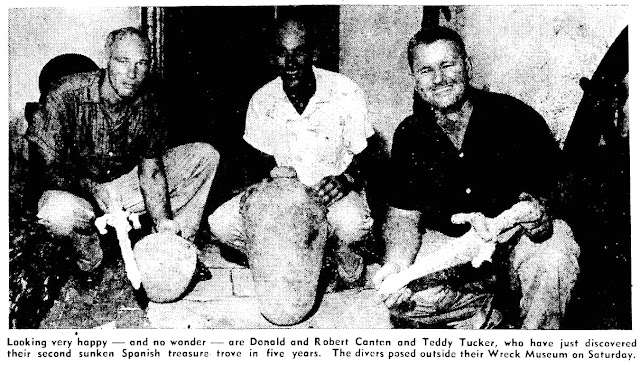




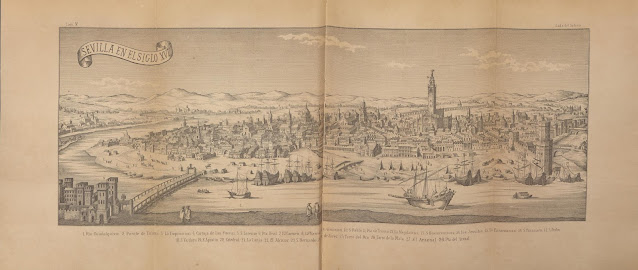

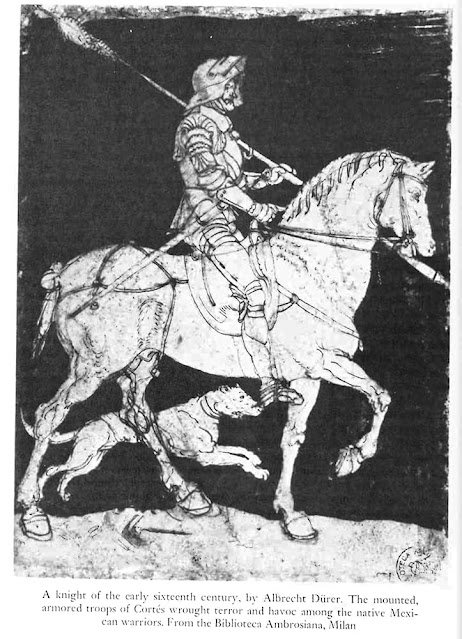





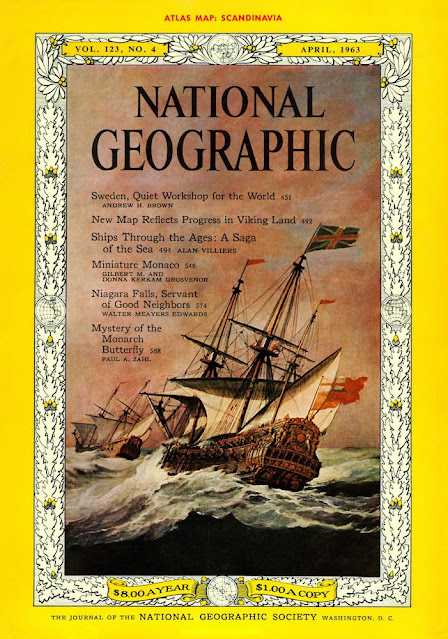








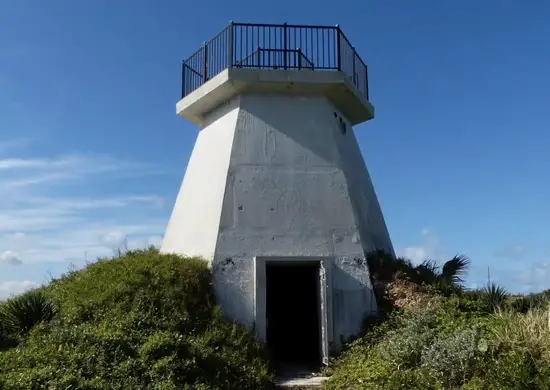
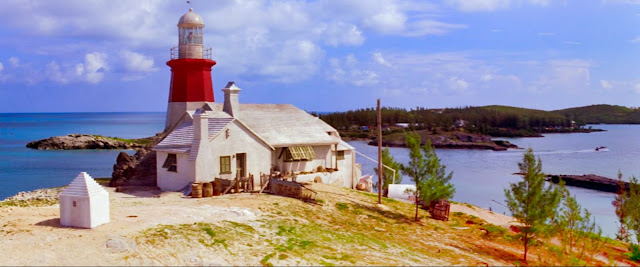


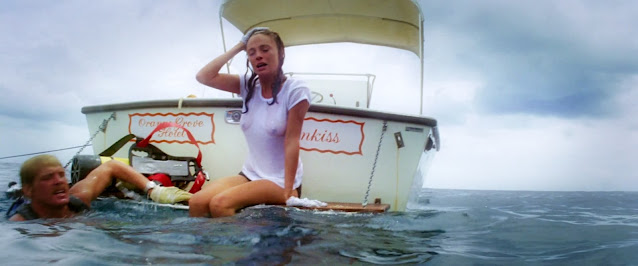

I worked as an extra during that summer and got to spend time with Bob Tessier on Coney Island below the lighthouse. I also got to drive my fathers car (Green Singer Vogue, I think!) in a chase scene around the narrow road outside Trinity Church, Baileys Bay. They mounted a camera to the rear and I had to stay ahead of the stunt doubles on mopeds, doing multiple takes. I had to stay in second gear (manual) in order to hang the corners tightly! but apparently I did some damage to the engine! I still have some photos I took of those times....Scott Stallard, STGeorges, Bermuda 2024.
ReplyDelete